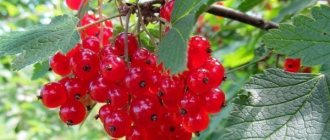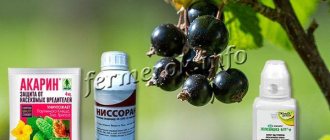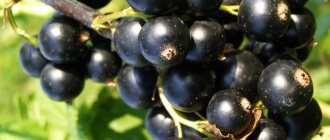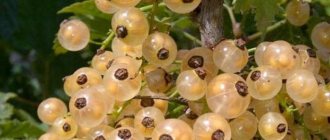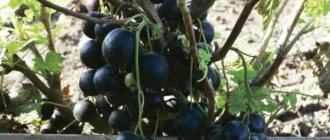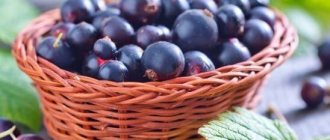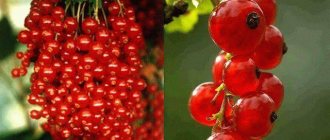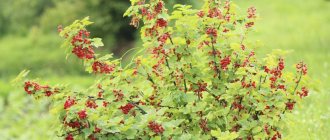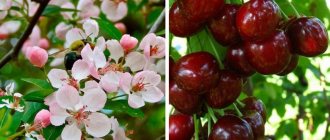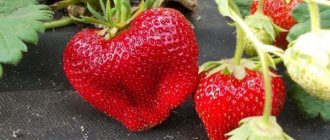Representing one of the most common garden crops. Early red currants are characterized by low demands on growing conditions and care; their fruits have an attractive appearance and a memorable taste.
Bred in the Pomological nursery (Moscow region) by domestic breeders A.P. Nitochkina and N.K. Smolyaninova, it was included in the State Register of Breeding Achievements in 1974 and recommended for breeding in the Central Black Earth, Volga-Vyatka and East Siberian regions of Russia. When breeding the variety, the Laturnais and Chulkovskaya varieties were used.
Characteristic
To describe the plant, you should pay attention to the size and appearance of the bush, the location of the buds and adult leaves on the branches, the characteristics of fruiting, the type and intensity of the taste and color of the berries. Below are the main characteristics of the Early Sweet red currant variety:
- The Early Sweet red currant bush is a plant of medium growth intensity; the shoots do not have pronounced pubescence; when fully developed, it is compact and semi-spreading.
- The height reaches 120-150 cm, non-woody shoots are greenish in color with a red tint, woody shoots are gray-brown. The buds are elongated, tightly adjacent to the trunk, single.
- The leaf of an adult plant has a wrinkled surface, three to five branches, and a light to dark green color. Along the entire surface of the leaf there are veins visible to the eye, located perpendicular to the base.
- The brushes on which fruiting occurs are quite long - they can reach 11 cm. They are light brown in color and bear saucer-shaped flowers.
- The size of ripe berries is small - the average weight is 0.6-0.11 g. The cluster is thickened, the diameter of the berries decreases from the top of the cluster to its base. The taste is pronounced sweetish, the color is bright red.
According to the tasting rating scale, the currant berries of this variety received 4 points.
History of selection
Early sweet red currant was obtained by Soviet breeders. Work on its breeding was carried out in the Pomological nursery of the Moscow region. N.K. Smolyaninova and A.P. Nitochkina worked on its creation. The basis for it was the Chulkovskaya and Laturnais varieties. The resulting seedling managed to absorb the best qualities of its ancestors.
In 1974, the Early sweet red currant was included in the State Register based on the results of tests carried out, which were able to confirm the declared characteristics. The species is recommended to be grown in the following regions: Central, Volgo-Vyatka, East Siberian; Central Black Earth.
Advantages and disadvantages
Representing a non-spreading bush, Early sweet currants will not take up much space in the garden plot. Also, the following qualities should be considered as the advantages of Early sweet red currant:
- good transportability;
- high productivity rate;
- no shedding of berries after they ripen;
- taste qualities;
- intensive growth;
- winter hardiness.
Positive qualities also include resistance to diseases and pests, and an early period of ripening of berries.
However, there are several disadvantages of Early red currants. This is a tendency to form excessive growth, increased demands on the composition of the soil and its nutritional value. For this reason, attention must be paid to choosing a planting site and maintaining soil quality.
White currant for the Moscow region
White currants are very similar to red currants in terms of the structure of the bushes and requirements for climatic factors. Until recently, it was considered a variety of red currant, only with white berries. Now it is classified as an independent group, although some breeders continue to consider it just a subspecies of red-fruited varieties.
Almost all varieties included in the State Register can be grown in the Moscow region and the middle zone. They are quite winter-hardy and frost-resistant and can perfectly tolerate unfavorable factors in these conditions. Foreign varieties (in particular, Ukrainian ones) can tolerate winter conditions well with shelter.
Smolyaninovskaya (white Smolyaninovskaya)
Currants were bred in the mid-90s using intervarietal crosses. Grows well in the Moscow region, the middle zone and the north-west.
Smolyaninovskaya, medium-early ripening, universal purpose. The bushes are medium-sized, rather spreading. Fruit clusters of medium length. The fruits are round-oval, translucent, white. The taste is sweet and sour, refreshing (4.7 points).
- yield 3.3 kg/bush;
- berry weight 0.6 g;
- vitamin C content 32.6 mg/%.
Advantages. Good yield, excellent taste. High frost resistance. Resistance to powdery mildew.
Flaws. Affected by anthracnose.
Bayana
The currant was obtained in the mid-2000s. Late ripening.
The bushes are vigorous, dense, slightly spreading. Annual shoots have a reddish tint. The berries are large, smooth, round, white, translucent. The taste is pleasant sweet and sour. Seeds are few in number, orange in color.
- yield 2.2 kg/bush;
- berry weight 0.5-0.7 g;
- vitamin C content 40.3%;
- substance content: sugar 7.6% acid 1.8%.
Advantages. Good yield, dessert qualities of fruits. High winter hardiness, resistance to powdery mildew.
Flaws. Affected by red gall aphids. Affected by leaf spots.
Snezhana
Currant of Ukrainian origin. In the middle zone it winters with shelter. In severe winters it can freeze.
Medium ripening, universal purpose. The bushes are medium-sized, slightly spreading. The brushes are long and very thick. The fruits are one-dimensional, white, transparent, large, with thin skin. The taste is refreshing, pleasant, sweet and sour. Ripening is amicable, the currants practically do not fall off. Snezhana is suitable for storage, processing, canning, and freezing.
- berry weight 0.6-0.8 g;
- vitamin C content 84 mg/%;
- substance content: sugar 5.5-8.2%, acids 1.2-1.3%.
Advantages. High winter hardiness and drought resistance, good heat resistance, resistance to powdery mildew, septoria, anthracnose. High yield, good taste of fruits. Suitable for storage (5-7 days).
Flaws. Insufficient frost resistance in the conditions of the Moscow region and the middle zone.
Umka
Currants of mid-early ripening, universal purpose. The bushes are medium-sized, spreading, medium-dense.
The fruits are large, smooth, white with a yellowish tint, transparent, with thin skin. The number of seeds is medium, they are large and orange in color. The taste is sweet and sour, pleasant (4.6 points).
- yield 2.5 kg/bush;
- berry weight 0.8-1.0 g;
- vitamin content 54.0 mg/100 g;
- substance content: sugar 9.5%, acids 1.6%.
Advantages. Excellent taste, very high winter hardiness, sufficient frost resistance. Good heat resistance. Resistant to powdery mildew and gall aphids. It has proven itself to be excellent in the Moscow region.
Flaws. Drought resistance is average. Insufficient self-fertility (30-35%), pollinating varieties are required to increase productivity.
Rose Chair
This currant is classified either as a red or a white variety. The color of its berries ranges from white with reddish streaks to white-pink. Color may vary slightly from year to year.
Rose Chair is medium ripening, universal purpose. The bushes are medium-sized, of medium density, slightly spreading. The fruits are medium and large, smooth, round, translucent, white-reddish in color (sometimes red-white, the color depends on the light). The taste is sweet with a slight sourness.
- berry weight 0.5-0.8 g;
- the yield is average.
Advantages. Excellent dessert taste of the fruit. Resistant to septoria.
Flaws. The yield is not very high. Affected by powdery mildew and anthracnose.
For a family of 3-5 people, 3-4 currant bushes of each type are enough to have berries all summer long.
Landing Features
To obtain a high yield, it is recommended to adhere to several planting rules. Read about planting and caring for the Sakharanaya blackcurrant variety here.
Selecting a location
For early ripening, it is better to plant bushes in lighted areas.
The method of planting Early red currants along paths and fences has proven itself to be excellent.
To prevent increased disease of the plant, crushing and sour taste of berries, places with close contact with groundwater should be avoided.
Landing dates
It is mandatory to comply with the recommended timing of planting seedlings: late August - September - this period allows the plants to take root. This article will tell you about the red currant variety Gross.
Site preparation
It is important to prepare the soil correctly:
- the optimal period for preparing the soil for planting red currant seedlings is 2 months, when organic fertilizers are applied to the ground;
- when planting several bushes, the distance between them is 1.2-1.5 m;
- for the bush, a hole measuring 0.4 m x 0.5 m is dug, into which rotted manure (7 kg), superphosphate (200 g), and potassium sulfate (30 g) are added;
- the soil is mixed with the above mixture, poured into the hole when planting and mulched with sawdust.
Selection of seedlings
You should choose the right seedlings. Important criteria are:
- there must be two main roots with a large number of adventitious roots, their length is at least 0.5 m;
- the trunk does not have any obvious damage or tubercles, it is white at the break: the presence of blackness is evidence of damage to the plant by glassworm;
- appearance of the buds - they should have an elongated shape, not be spherical.
Landing instructions
A step-by-step process will avoid mistakes and provide conditions for rapid growth and high yield of the plant. The sequence of actions when landing is as follows:
- Blooming leaves are removed along the entire length of the lower part of the seedling.
- The seedling is placed in water for several hours.
- A hole is dug.
- The bottom of the pit is lined with drainage - broken bricks, pebbles.
- A mound is formed into which the seedling is placed at an angle of 45°C. The root neck is buried into the ground to a depth of no more than 5 cm.
- Next, the bush is buried and the earth is compacted.
A hole is made around the seedling, into which after planting you need to pour 2 buckets of water.
To prevent the soil around the seedling from drying out quickly and weeds from appearing quickly, it is recommended to mulch the planting site with sawdust, peat or wood shavings. Humus or straw can be used.
Growing red currant "Early sweet"
To successfully grow currants and get a rich harvest, you need to choose the right site for planting and buy high-quality seedlings.
Site selection and preparation
The favorable period for planting red currants is the end of summer or the beginning of autumn. If seedlings are placed in open ground later, the likelihood of plant death increases. They will not have enough time to build up the root system and prepare for the winter.
The "Early Sweet" variety prefers open places where the sun's rays freely enter. Areas along fences or garden paths are suitable for planting. The fence will protect the bushes from drafts. If red currants grow in shaded areas, the crop takes on a distinct sour taste and does not ripen to the end.
Currants require loose soil that allows air to pass through well. Sandy loam, slightly podzolic or loamy soils are suitable. Acidity levels should not be higher than 6.5 pH.
High places are selected for shrubs so that groundwater does not pass at a level above one and a half meters. If there are no natural hills on the site, you can create artificial hillocks with a developed drainage system. In lowlands, which are often flooded and retain moisture for a long time, the bushes quickly become sick and die.
The selected site must be prepared two months or two to three weeks in advance. Planting holes are dug at a distance of one and a half meters from each other. The width of the hole should be forty centimeters, and the depth should be half a meter. If necessary, organize drainage by adding pebbles or broken brick to the bottom in a layer of ten to fifteen centimeters.
Add 7-9 kg to the dug planting pit. rotted compost or manure, 200 gr. superphosphate and 35 gr. potassium sulfate. Instead of potassium, you can add 300 grams. wood ash.
2 buckets of water are poured into the hole and the hole is covered with wood shavings or sawdust. Instead of the above components, it is allowed to use store-bought soil mixtures for garden plants.
Before purchasing, carefully study the composition, because chloride fertilizers have a detrimental effect on red currants.
How to choose seedlings?
For cultivation, you should choose seedlings 2-3 years old. There are also mature bushes on sale that are more than five years old. Planting material is carefully chosen so as not to buy a weak or dying plant.
The root system must be developed, without damaged or dried parts. It must necessarily consist of two main roots and several secondary roots at least half a meter long.
In a healthy plant, the shoots reach a height of 40 cm. They are covered with smooth bark, there are no irregularities or bumps. You can turn a blind eye to minor peeling of the bark if there are no parasites and the shoot remains elastic. Pay attention to the cut: it should only be light in color.
A dark cut indicates the presence of glass. It is best to purchase planting material from nurseries or specialty stores. There they create the necessary conditions for red currants, as a result of which they remain healthy until sale.
Planting process
Before planting, remove the blossoming leaves from the plant and immerse it in water for one to two hours. Then the red currants are placed in a mixture of clay and soil, to which a root development stimulator is added, for example, “Kornevin”, “Kornerost”.
Photo of currant planting scheme:
Proceed to direct landing:
- A seedling is lowered into the hole, positioning it at an angle of 45 degrees so that the plant takes root faster. The root neck is deepened by 6-8 cm.
- The dunka is covered with soil and carefully compacted with foot so that there is no air left in the hole.
- A trench is made around the tree trunk circle into which 15 liters of water are poured.
- The hole is covered with mulch, such as peat, wood shavings or sawdust.
- The shoots are cut to 1/3 of the length or half. Make sure that after the procedure there are 3-4 buds left on the branch.
Read more about planting currants.
Seedling care
To ensure high yields of the Rowada, Viksne and other varieties, it is necessary to properly water and prune the plant, stimulating the rapid formation of fruiting clusters and preventing the appearance of shoots.
Trimming
For better formation of new leaves and rapid development of the bush after planting, it should be pruned. To do this, the above-ground part is shortened by 1/3. There should be 3-4 buds left on the trunk. Pruning is done in early spring or after harvesting in the fall. Find out about popular varieties of pink currants at this link.
The process of forming a bush begins a year after its planting. 3-4 of the strongest shoots should be left, the rest of the shoots should be removed.
A properly formed bush of all varieties of currants, including Altai, red Sugar and Early sweet, should consist of 15-20 healthy branches. The most productive age of red currants is 3-5 years.
Starting from the 6th year, old branches are completely removed; when pruning them, no stump should remain. From the age of 8, rejuvenating pruning is carried out, for which old branches are cut out to the point of their strong branching. Pruning should be done towards the upper active stove.
Watering
Early currants, like the Lazy Tree variety, tolerate short-term drought, but in the absence of rain for a long time, they should be irrigated. To maintain the health of the bush, abundant watering is carried out three times a year:
- when berries ripen;
- after harvest;
- pre-winter watering.
A young bush requires 30-40 liters of water, an adult - 40-50 liters.
To preserve moisture in the soil for a long time, it is recommended to mulch the root area after watering. For this, humus, sawdust, shavings, and straw are used.
Top dressing
Active growth of bushes and sufficient fruiting are ensured by fertilizing.
In the spring, 80-100 g of urea is added, which is used in the first portion during shoot growth, and the second portion is used during the formation of berries. In summer, liquid mullein or bird droppings are digestible. The area under the crown is fertilized with a mixture of rotted peat, potassium sulfide (50 g) and superphosphate (100 g). After fertilization, the soil is loosened and mulched.
Shelter for the winter
The variety Early sweet red currant is frost-resistant, but to preserve it, it should be covered with special covering materials before the onset of severe cold.
To do this, a cocoon of covering material is formed around a bush, the branches of which are interconnected.
Reproduction methods
You can propagate red Early sweet currants in several ways:
- By layering. The soil is loosened near a suitable bush. From the central part of the bush, grooves are dug under strong shoots 1-2 years old. The branches are bent and placed in grooves, secured with iron staples made of wire. The depth of the furrows should be 5-7 cm, and the length should correspond to the size of the branches, which are covered with earth, leaving only the tops above the surface.
As the shoots grow, they are periodically sprinkled with soil. When the sprouts reach a length of 10-12 cm, they are hilled. The soil must be kept moist at all times. Grounded branches are cut from the main bush at the end of September and carefully dug up. The branches are divided into parts, the number of which must correspond to the number of formed and rooted shoots. Poorly developed layerings of the Early Sweet variety are grown throughout the year, the rest are planted in the soil.
- Lignified cuttings. At the end of August or early September, sanitary and rejuvenating pruning of sweet red currant bushes is carried out, during which several healthy shoots are selected, all foliage is removed from them and divided into parts about 20 cm long. The upper cut should be straight and pass over the bud, the lower an oblique cut is made under the kidney. Each shoot should have 4 buds.
The cuttings are treated with root-forming stimulants and grounded in loose nutrient soil for rooting at an angle of 45 °, leaving 1-2 buds above the surface. A distance of at least 10-15 cm is left between the planted cuttings of red Early sweet currants. The beds are regularly watered and periodically mulched with mature compost or peat. If the cuttings were planted late, they are covered first with spruce branches and then with non-woven covering material to protect them from frost. To ensure that the humidity level is optimal, the soil is covered with black film and only then the cuttings are planted, making holes in it. In this way, the soil will be protected from drying out, and the cuttings will form a root system much faster.
- Green cuttings. In June, during the period of the most intensive emergence of shoots, the shoots are cut off along with part of the mother branch. Then the cuttings are taken so that the length of the shoot is 5-7 cm, and the branch on which it grew is about 4 cm. The lower leaves are removed so that they do not interfere with planting. The finished cutting is planted by placing part of the old branch horizontally and deepening it into the soil by 3-4 cm. The young shoot should be positioned vertically. The beds are watered, moistening the soil to a depth of 7 cm, and mulched. It is necessary to shade the plantings from the hot sun. The cuttings are planted in a permanent place of growth after a year.
- Dividing the bush. This method helps when it is necessary to transplant the bush to a new location. To do this, dig it up, after cutting off all the old and damaged branches. The roots are shaken off the ground and cut into pieces with a sharp shovel. A young bush of Early sweet currant is divided in half, and 3-5 parts are obtained from adults.
Each division is buried in the soil 5-7 cm deeper than the mother bush was previously located. Green seedlings are shortened, leaving 15-20 cm above the soil. Until the cuttings take root, they must be watered frequently and abundantly every day.
Attention! Each owner of a garden plot can independently decide how to propagate red Early sweet currants.
Diseases and pests
Red currants are resistant to the negative effects of pests. The following pests can occur if agricultural cultivation practices are not followed:
- spider mite - the fight against it consists of removing weeds and fallen leaves;
- glass - requires regular loosening and removal of weeds;
- gall aphid - you should dig up the ground and burn fallen leaves.
This material will tell you about brown spots on currant leaves.
Currant diseases - anthracosis, columnar rust, septoria.
How to care for black currants.
Regardless of what variety you grow, the basic rules for caring for blackcurrants should always be followed:
- Planting is the best place for currants in partial shade.
- In early spring - preventive treatment of the bush with boiling water.
- In early spring - pruning the bush.
- During the year - watering, loosening, protection from pests.
- In spring and autumn - fertilizing with organic fertilizers or mineral fertilizers containing nitrogen.
Harvest and storage
From one bush you can collect 3-3.5 kg of berries. They store and transport well, and have dense, juicy flesh. To prevent bruising of the berries, you should use a wooden container with a volume of no more than 4 kg.
The harvest can be stored fresh in the refrigerator for up to 10 days, in the freezer for 3 months.
During secondary freezing, the berries lose most of their nutritional value, so freezing should be done in portions. The berries are harvested when they are completely ripe - they contain more vitamins.
How to process currants with boiling water
Treatment with boiling water is one of the most effective and healthy methods for preventing blackcurrant diseases: such treatment helps fight mites, powdery mildew, aphids and fungal diseases.
Treatment is carried out only before the start of sap flow in early spring. Before treatment, branches damaged by mites are cut out - in the lower part they have a round growth in which mites overwinter. Cut branches are burned.
After this, the blackcurrant bushes are doused with boiling water at 60-80 degrees. Contact of hot water with the branch should be no more than 5 seconds. During processing, the roots of the bush must be protected with oilcloth or boards. Water consumption: 1 bucket for 2-3 bushes. Each branch must be carefully processed. The presence of untreated pieces will lead to subsequent infection of the entire bush.
conclusions
The following qualities should be considered important conclusions for culture lovers:
- Being a universal garden crop, Early red currant is easy to care for, high-yielding, and easy to transplant.
- To maintain productivity and prevent diseases, proper agrotechnical care should be carried out, the bush should not be overgrown with weeds, and fertilizers should be applied in a timely manner.
- Active crop formation allows you to obtain a significant amount of it even from one bush.
- The high biological value of the berries and their good shelf life make it possible to preserve the harvest for a long time.
- Purchasing seedlings from trusted sellers will prevent the purchase of low-quality material.
Constant interest in the crop and its characteristics attract both novice gardeners and more experienced ones. Find out when red currants ripen here.
Harvest
Fruit harvesting is carried out in several stages, as the tassels ripen. Early red currants ripen gradually. This extends the time of eating ripe fruits straight from the bush.
Red currant berries are collected along with a twig
Overripe bunches do not lose berries, continuing to maintain a pleasant appearance and suitability for consumption and processing. The harvest is not harvested as individual berries, but rather the whole cluster is picked.
Video: picking and storing berries
How to propagate black currants.
The plant propagates in three ways - cuttings, layering and dividing the bush.
Reproduction by layering:
Propagation by layering is an easy method that is carried out in early spring and allows you to obtain excellent planting material:
- choose a two-year-old branch that can be easily bent to the ground;
- mark on the ground where the middle of the branch comes into contact with the ground;
- at the marked place, dig a hole up to 10 cm deep;
- Bend the branch with the middle part into the hole, secure it to the ground with wire and cover it with soil;
- the top of the branch should protrude 25 cm above the soil level.
With regular summer watering, you will get a strong seedling with a powerful root system. With the arrival of autumn, you can plant it separately.
How and when to plant blackcurrant cuttings:
Seedlings from cuttings are not as strong as when propagated by layering, but this method has its advantages. This is an opportunity to receive planting material all year round and plant it at a convenient time - in spring or autumn.
Separate the cuttings at the end of October, and in the spring they can be planted on the site. To do this, cut out the middle part of a strong annual shoot up to 25 cm long and up to 10 mm wide. Dip the shoot sections in paraffin, tie the cuttings of the same variety with thread, and wrap them in a damp paper napkin. Wrap the resulting packages with film and store under a layer of snow or in the freezer.
Plant the resulting cuttings immediately after the snow melts:
- Before planting in open ground, cut off the lower part of the seedling at an angle with a damp knife to remove any remaining paraffin;
- dip the cuttings into the prepared soil at a slight angle, leaving a few buds;
- the distance between seedlings should be at least 15 cm;
- Water the beds well and lay a layer of mulch;
- cover the beds with plastic film until the first leaves appear.
In the future, water the young shoots and remove weeds as necessary. You can also feed the soil with a solution of cow manure infused for 2 days (0.5 buckets of fertilizer per 4 buckets of water). To the same mixture you can add 10 g of superphosphate and 500 g of ash. With the onset of autumn, transplant the young seedlings to a permanent place.
If you did not have time to prepare cuttings in the fall, you can cut them in early spring. In this case, the planting material is immediately dipped into the soil, after which it is covered with a layer of mulch and film.
In mid-February, you can take fresh cuttings from the bush and place them in water. As soon as the roots grow and become stronger, plant the sprouts in disposable cups, and when it gets warmer, in open ground.
Reproduction by dividing the bush:
Dividing the bush is suitable for propagation in cases where it is necessary to rejuvenate a plant that is more than 15 years old:
- in the spring, dig up a bush, remove old and damaged branches from it;
- pinch the tops of young branches;
- divide the bush into several parts, each of them should have 2-3 strong shoots;
- Dig the resulting seedlings into the ground and water generously.
Currant cuttings need to be watered all summer, and by autumn they will take root well and produce many new shoots.
Follow all the growing recommendations correctly, and black currants will annually produce a large harvest of large and tasty berries that are so beneficial for your health.
The fruits of this plant are best consumed raw, but can also be canned, frozen or dried for the winter. There is always a use for currants, and the more of them, the better.
Blackcurrant: proper watering
Currant is a fairly unpretentious shrub. It grows well in the shade and loves moist, fertile soil. She will forgive you almost everything except the lack of sufficient moisture, especially in the spring during flowering. If you want to get a good harvest of currants, then don’t be too lazy to water them generously in the spring. Moreover, watering is needed not so much for the roots as for the flowers. To form large sweet berries, currants need high air humidity. And if dense morning fogs are rare in your region, then simply place a hose with a divider next to the bush and water it generously. When the time comes to harvest, the result will please you and you will forever remember this little trick for a high yield of your blackcurrants.
